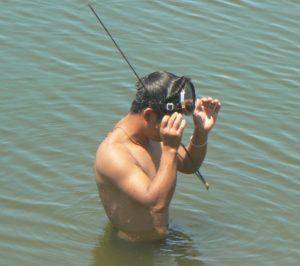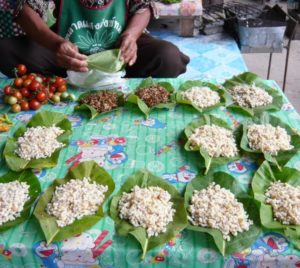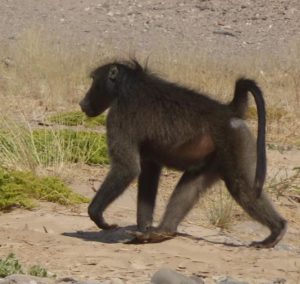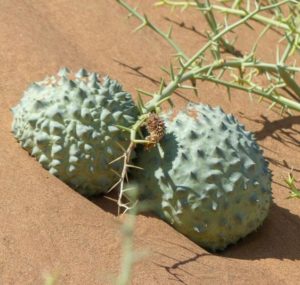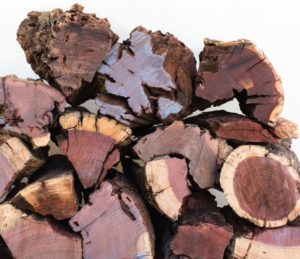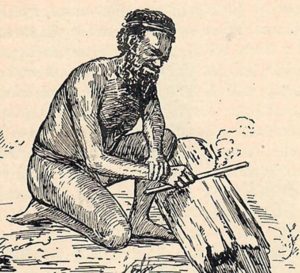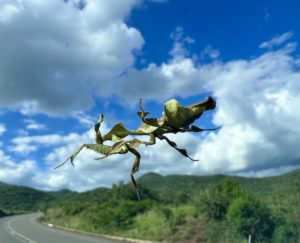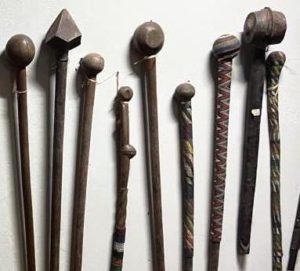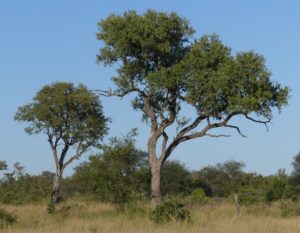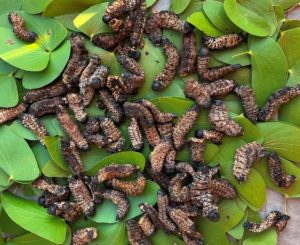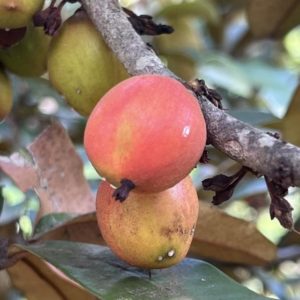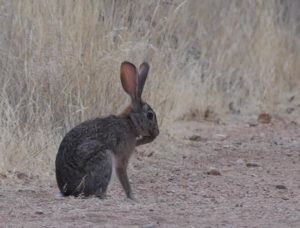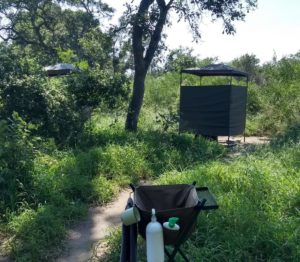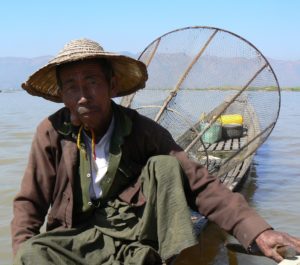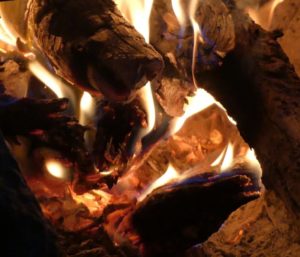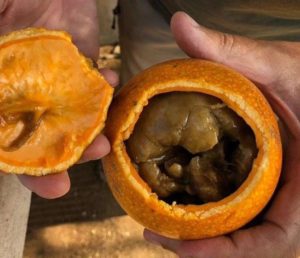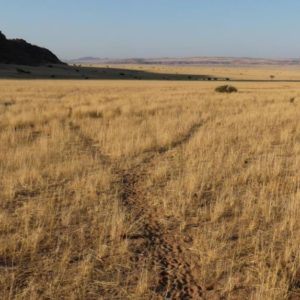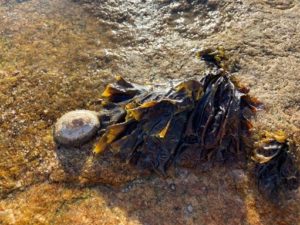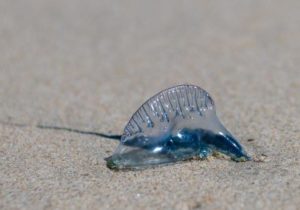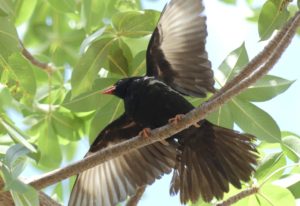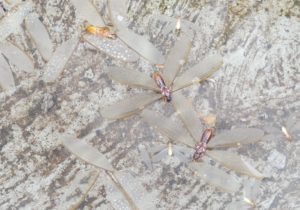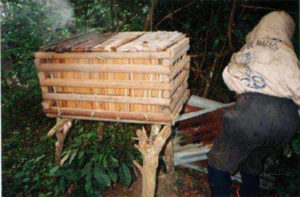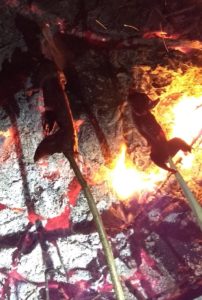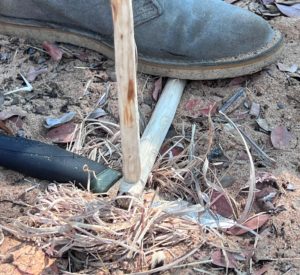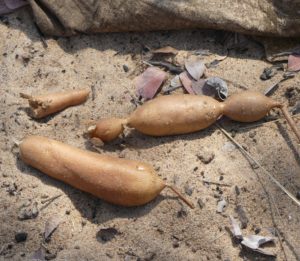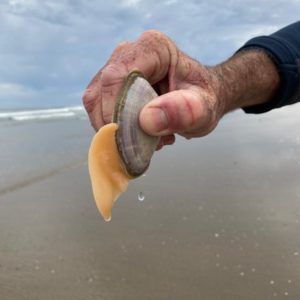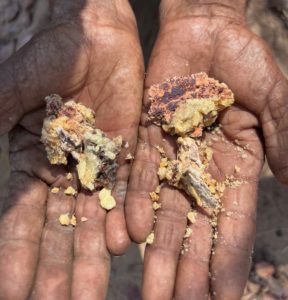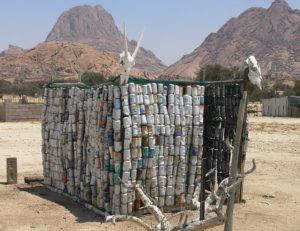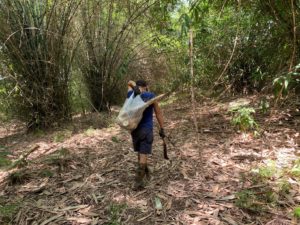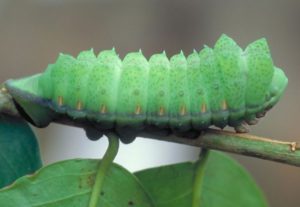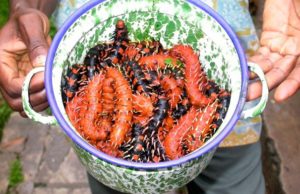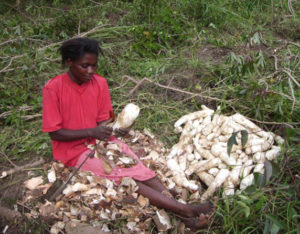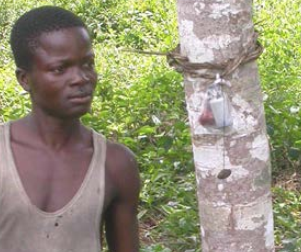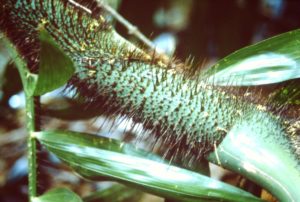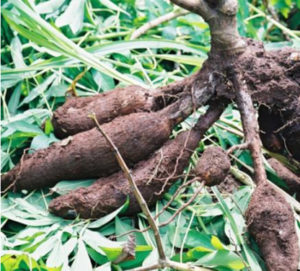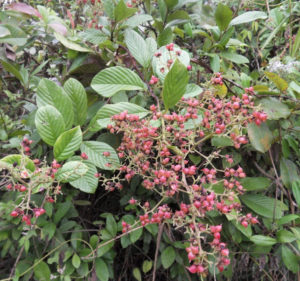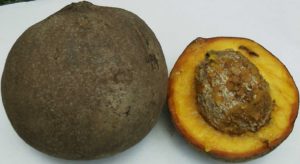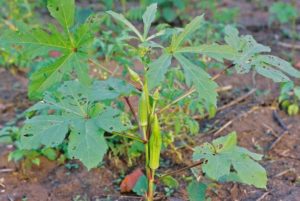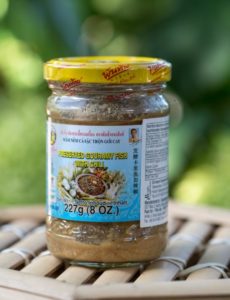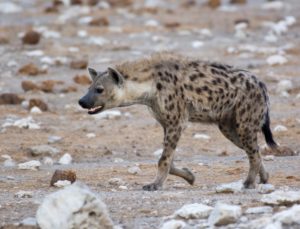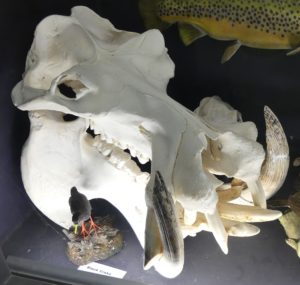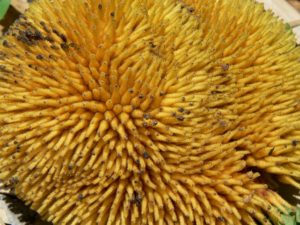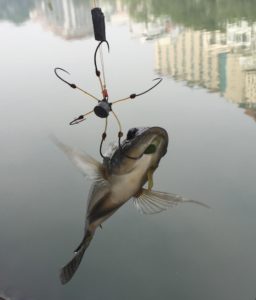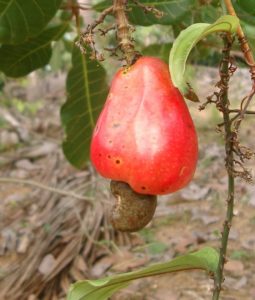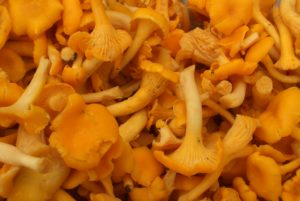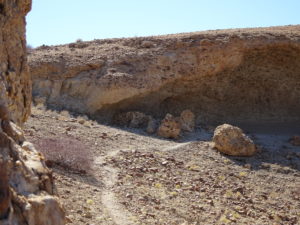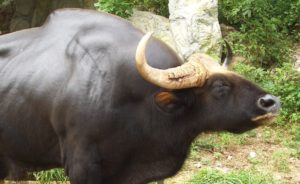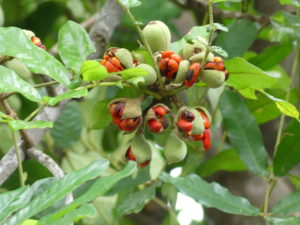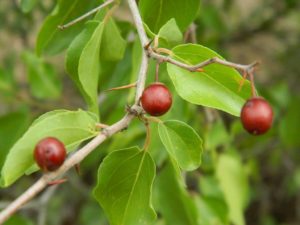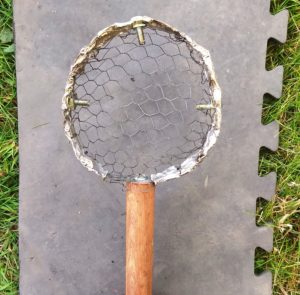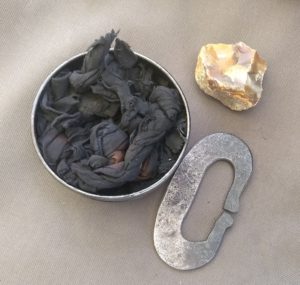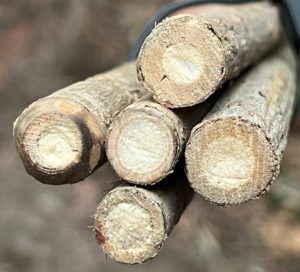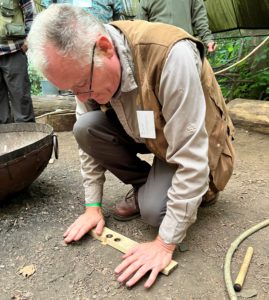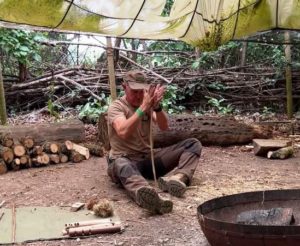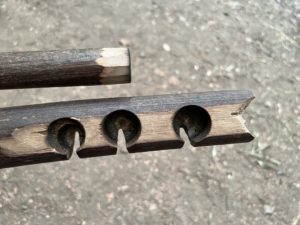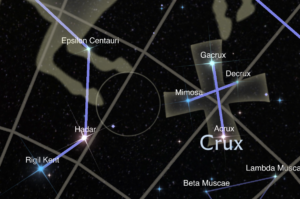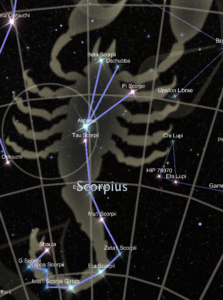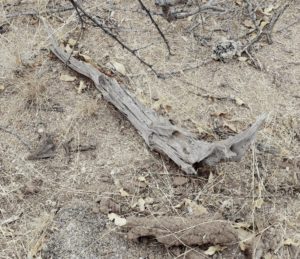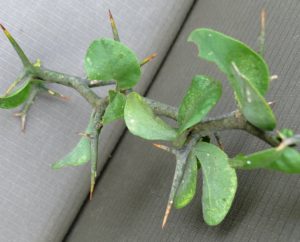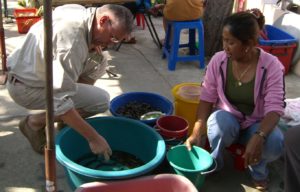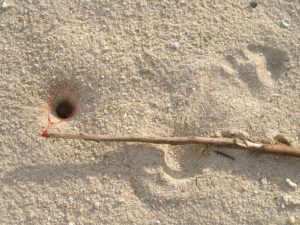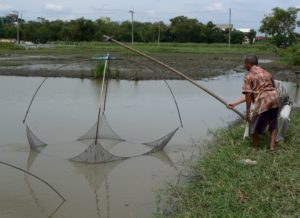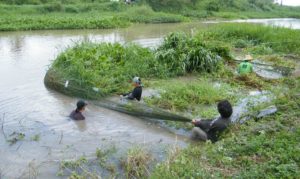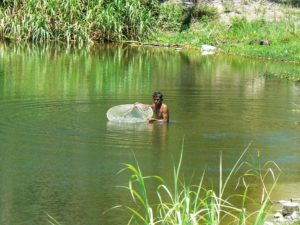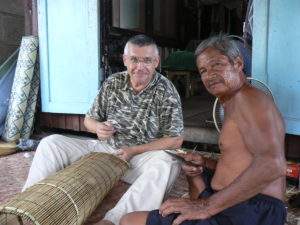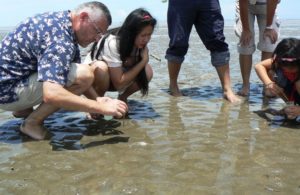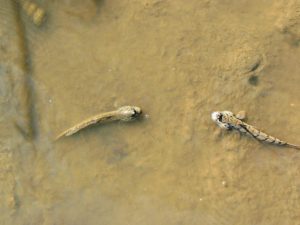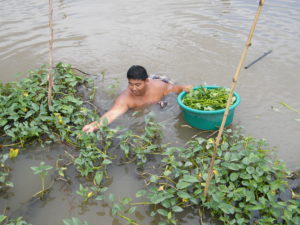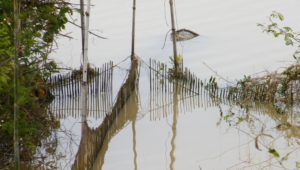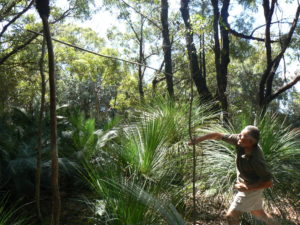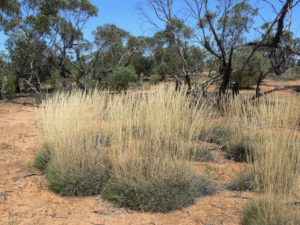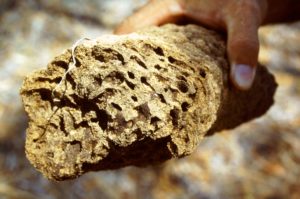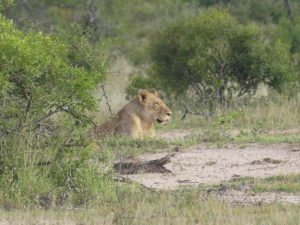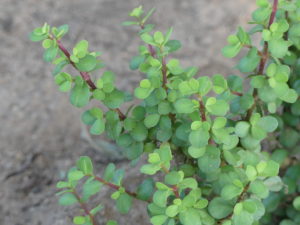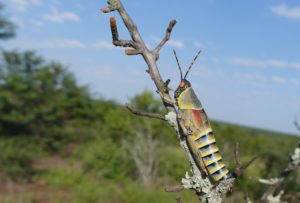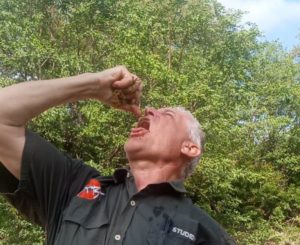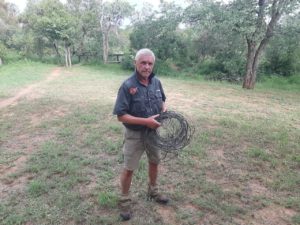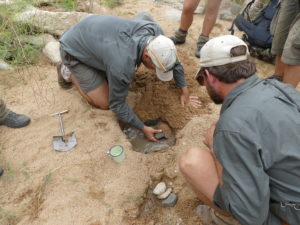Skills
Description of a speargun for freshwater fishing
In the following, we will briefly describe a specific speargun for freshwater fishing, which I bought from a fisherman in the northern suburbs of Bangkok, Thailand. It is neither as primitive as many of these guns are, nor is it…
Mechanically propelled darts for freshwater fishing
Mechanically propelled darts for freshwater fishing are commonly used all over Thailand. Many craft these devices themselves, so there is a wide variety of principles, styles, and designs. Besides homemade spearguns, where every piece is unique, industrial manufacturing is also…
Weaver ants got interesting traits
Weaver ants of the genus Oecophylla consist of two different species. One species is Oecophylla longinoda, which occurs in equatorial, tropical African regions. The other species is Oecophylla smaragdina, distributed in tropical Asia and Australia. Both of them are also…
Sansevieria leaves and their uses
Sansevieria and its leaves were a genus of flowering plants originating in Africa and southern Asia. This former genus comprises approximately 70 species, commonly known by English names such as mother-in-law’s tongue, bow string hemp, snake plant, and snake tongue….
Water dispensers for handwashing
In the former Soviet Union- and its satellite states, many citizens had and have water dispensers in their so-called ‘Dachas’ (Russian: дачи). Dachas are typically simple, free-standing houses located in city suburbs or the countryside. And most of them do…
Chacma Baboons – a dangerous nuisance
Baboons are one of the largest-sized Old-World monkeys. Due to hybridization, their taxonomy is contested and overlapping. In Africa there are six species of baboons, and in Southern Africa lives one species, which is Chacma baboons (Papio ursinus). Chacma baboons…
Nara melons: Bread of the Namib desert
Nara melons were, in former times, the only food Topnaar people had available for four months (Jan – April) a year. They used conserved fruit pulp and seeds to supplement other food sources for the rest of the year. They…
Camelthorn as firewood
Camelthorn is an excellent firewood in Southern Africa. Its outer layer is light-colored sapwood, and its dark, hard, and heavy heartwood is inside. This hardwood produces long-lasting coals and high heat. Its northernmost distribution area extends from the Northern Cape…
Grey Foam-nest Tree Frogs
Grey foam-nest Tree Frogs (Chiromantis xerampelina) are called ‘Southern Foam-nest Tree Frogs’ or ‘Foam-nest Frogs’. Their native distribution range is Southern- and Eastern Africa, in various habitats. Minimum habitat requirements are temporary pools of water with trees overhanging branches. The…
Australian Firesaws
Firesaws are only known as a traditional fire-making method on the Pacific Islands. In Australia, these methods were replaced by friction fire hand drills and later, under Western influences, by bow drills. Nevertheless, fire sawing is an interesting technique, which…
Ghost Mantises are impressive insects
Ghost praying mantises (Phyllocrania paradoxa) fit perfectly into our new homepage section called ‘Wonders of Nature’ due to their unique appearance and behavior. They are a species of praying mantis, and four characteristics make them unique. These are an impressive…
Himba smoke shower
The Himba women continue practicing traditional personal hygiene methods, including using a smoke shower and a mixture of red ochre and butter-fat paste. These Indigenous people are properly referred to as the ‘OvaHimba’ when plural and are mainly semi-nomadic, residing…
Knobkerries at a Museum in Hluhluwe
Knobkerries are straight, wooden clubs with a knob on one end. Together with assegais (throwing spears), they are the symbols of various African nations. These two weapons are part of the South African Coat of Arms, introduced in April 2000….
Koppie Foam Grasshoppers
Koppie Foam Grasshoppers (Dictyophorus spumans) are indigenous to South Africa and prefer sparse and low vegetation on rocky outcrops. They are flightless and have some aposematic coloring, which are yellow or orange stripes on the warty thorax shield and stripes…
Determining cardinal points by trees
Determining cardinal points by trees in Southern African savannas (Southern Hemisphere) is a standard procedure. It is helpful in case one is lost, and the sun cannot be seen. At least one can determine where the cardinal points are. Cardinal…
Mopane worms – high protein food in Africa
Mopane worms (Instars of Gonimbrasia belina) are mainly found on Mopane trees (Colophosperma mopane) but also on Wild Syringa (Burkea africana), Zebrawood (Microberlinia Brazzavillensis) and others. However, Mopane trees are a highly dominant species in climates and areas suitable for…
Milkplum (Stamvrug) fruits grow directly out of the tree trunk
Milkplum (Englerophytum magalismontanum (Sond.) T.D.Penn). Common names: (Afr) Stamvrug. (Eng) Milkplum, Wild plum. (isiZulu) Amanumbela. (Northern Sotho) Mohlatswa. (siSwati) UmNumbela. (Tshivenda) Munombelo. (Xitsonga) Nombhela. Old name: Bequaertiodendron magalismontanum Distribution Milkplum is widely distributed from Central Africa to Botswana and Eastern…
Termite soil as building material
Termite mounds are primarily made of soil, excavated below the mound, and carried to the surface by these insects. They use the soil to construct the mound, forming it into various shapes depending on the termite species. The exterior of…
Determining wind direction in savannas
Determining wind direction is necessary when on a hunt or trail in Southern African wilderness areas. Besides being constantly aware of the direction of the wind, the relationship to the sun has to be checked all the time. Only when…
Safari toilet at Timbavati tented bush camp
A safari toilet is essential for any temporary tented camp in the wild. For a Trails Guide course at Timbavati Private Nature Reserve in South Africa, we had eight students, two mentors, and one cook, a total of seven tents…
Salt intake at seashore survival activities
The salt intake of a human in case of an actual survival situation or when living from the provisions of a shoreline by purpose is of utmost importance to its health. If too much salt is consumed, the body has…
Parabuthus scorpions at Erongo province
Parabuthus scorpions are commonplace in Erongo province in Namibia. The area has unique geology, including red sandstone formations and granite mountains. It has a rugged, arid landscape with rocky outcroppings, mountains, and canyons. This area is home to several species…
Traditional fishing at Inle lake in Myanmar
Traditional fishing at Inle Lake is endemic and specific to this local environment. Inle Lake is the second largest lake in Myanmar, approximately 50 square miles (abt. 116 km2). During the dry season, the average water depth is only 7…
Brief historical overview of man’s use of fire
Mankind’s use of fire goes back an extraordinary length of time. From humble collecting and guarding natural fires to producing fire by sparks or friction took about 1,5 million years. For more than 500,000 years, mankind has been producing fires…
Monkey orange, an eagerly sought-after fruit
Monkey orange is the collective common name for the fruit of at least five different Strychnos tree species, which occur from Durban/South Africa up to Western Tigray in Ethiopia. These fruits are highly delicious, and all parts of the trees…
Game trails towards water in African savannas
Larger herbivores in African savannas formed game trails by regular use over eons of years and many, many generations. These trails connect water sources and feeding and bedding areas within their home range. And for a few of them, they…
Is your firewood wet or dry?
If you are outdoors in boreal forest biomes worldwide, protecting yourself against wind and wetness is paramount. And to light a fire for warmth. The necessary firewood should be dry to burn hotter and with less smoke. But if you…
Chewing sticks for dental care in Southern Africa
Chewing sticks, or toothbrush sticks, were widely used in former times from Ethiopia down to the southern tip of Africa. Nowadays, plastic toothbrushes are commonly used, and chewing sticks are still commonplace only in very rural parts of this area….
Purple Laver – cherished food in many cultures
Purple Laver (Porphyra capensis) belongs to a genus of cold-water seaweeds that grow in shallow seawater. More specifically, it belongs to the red algae phylum of laver species (from which comes laverbread), comprising approximately 70 species. It grows in the…
Field dressing and cooking a puff adder
Puff adders (Bitis arietans) are widely distributed throughout Sub-Saharan Africa, except in dense rainforest areas and Madagascar. They have a tell-tale flat head with a straight line between the eyes, a thick body with chevron markings, and a stumpy tail,…
Bluebottle jellyfish – a stingy creature
The bluebottle jellyfish, also known as Physalia utriculus, is commonly found along the coasts of non-tropical regions bordering the Atlantic, Indian, and Pacific oceans. These creatures are not jellyfish but rather siphonophores composed of multiple organisms known as zooids. These…
Finding direction with Buffalo weaver nests
The Red-billed buffalo weaver (Bubalornis niger) is a common bird in parts of Southern Africa. These birds have the largest body size of all weavers and are common in dry woodland and savannas. Buffalo weavers have a peculiar trait when…
African termite alates for food
In Southern Africa, Harvester termite alates (Hodotermes spp.) and Mound-building termite alates (Macrotermes spp.) swarm within a specific area usually once a year. These alates are winged termites, which termite workers keep within certain chambers in the mound. They represent…
Black mussels at the Namibian coastline
Black mussels in Namibia include the following species: Ribbed mussel (Aulacomya atra), Black mussel (Choromytilus meridionalis), Mediterranean mussel (Mytilus galloprovincialis), Brown mussel (Perna perna) and Bisexual mussel (Semimytilus algosus). In one of my former articles on this website, I discussed…
Wax extraction from honeycombs
For wax extraction, the empty combs are first put in water, which is heated until the wax melts. The liquid is then poured through a piece of coarse cloth, and while still hot, this is twisted or squeezed until as…
Improvised protective equipment for beekeepers
Locally made-up smokers and overalls are used for inspection or harvesting the hives as improvised equipment. These have also become expensive and are often shared by a group of beekeepers. Improvised protective overalls A protective bee suit enables the beekeeper…
Alternative beehives in D.R. Congo
In recent years the shortage and expense of timber and corrugated iron sheet have encouraged people to use alternative materials for beehives. The range of substitutes includes old 200-liter fuel drums cut in half. Their ends removed, and their sides…
Beekeeping in Congo, Central province
Honey hunting has been a traditional activity in Bas-Congo, as in much of Africa. But beekeeping in Congo has only been practiced in the area since the early 1980’s. The beehive in common use is the top bar hive which…
Skinning and processing of dormice in Slovenia
Before dormice can be skinned, processed, and cooked – they have to be caught. That is an art of its own and is described in an article under this Link here. Skinning and processing of dormice is done similarly to…
Manketti wood for friction fire lighting
In the northeastern parts of Namibia, Ju//hoansi Khoi-san bushmen preferably use Manketti wood (Schinziophyton rautanenii) for friction fire lighting, at least in areas where Manketti trees are growing. Such areas have slightly higher elevations compared to savanna bushveld vegetation. Both…
‘Bush potatoes’ from Cowpea plants in Namibia
Cowpeas (Vigna lobatifolia) are strong climbers that resemble Mung beans. The stem of this vine is up to 6 m long and develops trifoliate leaves. Its flowers resemble purplish pea-flowers, and the pods are about. 7 – 9 cm (2…
Safari footwear for hiking in African savannas
Proper safari footwear is essential for hiking in Southern African savannas. These savannas are defined by a lush grassy layer and a notable woody layer consisting of trees and shrubs, but neither dominates the biome. Depending on particular climatic conditions…
White mussels at the Namibian coastline
Description of White mussels White mussels (Donax serra) are wedge-shaped bivalves with coarse ridges across the posterior. The inner surface is smooth and has a purple tinge. It has a short, stubby inhalant and a long, thin exhalant siphon. It…
Dormouse trapping in southern Slovenia
Worldwide, the dormouse family consists of three sub-families and 29 species and in Slovenia the ‘European edible dormouse’ (Glis glis) is native. There live three other dormouse species: garden dormouse (Eliomys quercinus), forest dormouse (Dryomys nitedula), and hazel dormouse (Muscardinus…
Manketti (or: Mongongo) nuts
Manketti nuts are a staple food for a variety of people within its distribution range. And there is a strict division of naming them. Khoi-san people (Bushmen) call them ‘Manketti’, whereas Kavango people (Bantus) call them ‘Mongongo’. Both names denominate…
Wild Syringa (Burkea africana) edible tree resin
Many African trees extrude edible gums and resin. Notable Vachellia ssp. and Senegalia ssp. (old name: Acacias) are known for their edible gums. Khoi-sani people collect and eat whatever edible gums and resins they find on the go. In our…
Leaf huts as temporary shelters for shade
Members of the Khoi-san (Bushmen) tribe named Ju//hoansi are also called !Kung. Both the signs / and ! denote click sounds. The tribe is about 30,000 people spread over Namibia, Botswana, and southern Angola, with a central area at the…
Beer can hut near Spitzkoppe in Namibia
Empty aluminum beer- and pop cans will serve additional purposes after guzzling the content. Besides toys and various repair applications, these cans can build huts and houses! As can be seen in Texas, the US here, or Australia there, which…
Throwing sticks as weapons in the African bush
Kerries combine throwing sticks and wooden clubs as everyday tools for hunting, defense, and digging in Southern Africa. Australian aboriginals used a refined form of throwing sticks, flattened over its whole length and called ‘Kylie’ by them. Eventually, boomerangs evolved…
Bamboo shoot harvesting at the Red River
With more than 70 bamboo species throughout the country, we can easily find bamboo thickets anywhere in Vietnam. Many could nurture one of the most popular and favored vegetarian foods for Vietnamese people, bamboo shoot harvesting. Two main types of…
Breadfruits (Artocarpus altilis) in Central Africa
Synonyms A. communis, A. incises; Common names Kikwa ki santu Petelo (Kongo), arbre à pain (Fr.), breadfruit Description A tree up to 35m tall produces a wide crown. All parts of the tree produce a white, bitter latex. Fruits are…
Green caterpillars, called ‘Kaba’ in D.R. Congo
The name Kaba is used for several large green caterpillars. Lobobunaea phaedusa can be up to 10 cm long and is usually found singly between October and May. When disturbed the caterpillar contracts in defence. They are sometimes very difficult…
Coracles at Duy Hải, near Hoi An, Vietnam
Hoi An is located about 35 km south of Da Nang, which is roughly in the middle of mainland Vietnam. It is one of Vietnam’s most picturesque towns and attracts many tourists. Which in turn requires lots of fish and…
Bush Yams in Western- and Central Africa
Synonym: D. cayenensis var. praehensilis; Common names: Kisadi, sadi, Bisadi (Kongo), Igname de brousse (Fr.), bush yams, forest yam Description A sturdy climbing plant, up to 15 m long, growing from a large tuber that often protrudes from the ground….
Edible caterpillars Nudaurelia petiveri
This species (Nudaurelia petiveri) is widespread throughout western, central, and southeastern Africa. It appears in Kongo Central in December and January. Up to 200 eggs are laid in clusters on the undersides of young leaves. They hatch after about two…
‘Leopard claw’ grass for catching rats and mice
Common names Nkansu ngo (= claw of the leopard), Leopard claw grass, Nzefo za ngo, Kansingo (Kongo) Description A perennial grass with culms 30 – 150 cm high, growing from scaly rhizomes. Leaf blades are spear-shaped, 10 – 40 cm…
Indochina Dragon Plums from Hanoi streets
The Indochina Dragon Plum (Dracontomelon duperreanum) is a genus of flowering plants in the family Anacardiaceae. In Vietnamese, it is called chi sấu). Dragon Plums are one of the most popular trees on the side of Hanoi streets. The fruits…
Collection of edible caterpillars in D.R. Congo
Children are the main caterpillar collectors, though most people while walking in the bush, keep a constant watch for them. Frequently people will bring back young caterpillars and place them on trees near their homes where they can keep an…
Traditional processing of cassava in Congo
Image sequence of cassava’s long way from root to market and shows the processing of cassava in its various steps Source This article is an excerpt of Paul Latham’s and Augustin Konda ku Mbuta’s books ‘Useful plants of Kongo Central…
Edible Caterpillars for food in Congo
Rural families in Kongo Central find it very difficult to get sufficient protein to eat. Hunting has cleared out most of the larger animals and even many of the smaller animals, such as the cane rat, are now difficult to…
Rattan vine in Africa – Calamus deerratus
Synonym C. laurentii; Common names Nkau (Kongo), Rotin (Fr.), Rattan vine Description A slender to moderately robust rattan palm, climbing up to 20 m high and often forming dense clumps. The stems and leaves are armed with spines. Stems have…
Cassava, a staple food in Central Africa
Synonym: M. utilissima; Common names: Dyoko, Saka Saka (Kongo), Manioc (Fr.), Cassava roots Description A perennial shrub, up to 3 m high, with enlarged tuberous roots and a well-developed root system. There are many varieties, some of which are bitter…
Tetracera alnifolia – a vine for water shortages
Tetracera alnifolia (Dilleniaceae); Synonym T. alnifolia subsp. alnifolia; Common names Kiziazi, Nziazi, Nziazia (Kongo), Liane à eau (Fr.), Water tree Description A woody creeper up to 20 m long and up to 10 cm. in diameter. Leaves are 4 -…
Edible caterpillars in D.R. Congo – an introduction
My first experience with edible caterpillars took place in 1985 when my wife and I lived at Kavwaya near Kisantu in what was then the Bas-Congo province of D.R. Congo. On one occasion I was shown how to hunt for…
African mammee apple in West- and Central Africa
Common names are Mafambu, Dimbu dingi (dingi = gum, resin, incense) (Kongo), Bokodji (Lingala), African mammee apple, Oboto or Djimbo (commerce). Scientific name: Mammea africana. Description A large forest tree up to 45 m tall with a straight, cylindrical trunk…
Okra plants in D.R. Congo
Okra plants (Abelmoschus esculentus): Synonym: Hibiscus esculentus Common names Dongo, Lonto (Kongo), Dongo dongo, Molenda (Lingala), Gombo (Fr.) Description An erect annual herb usually 1 – 2 m. high. Leaves are 3 to 5 lobed, spirally arranged and may be…
Pla Ra – Thailand’s fermented fish condiment
Pla Ra (Thai: ปลาร้า, pronounced [plāː ráː]), is fermented fish. Traditionally, Thais in the Central and Northeast provinces (Isan) eat fish and rice. In these relatively poor provinces, there is only one rice growing cycle every year. The planting season…
Spotted hyenas are successful hunters
Spotted hyenas (Crocuta crocuta) occur throughout sub-Saharan Africa. Exceptions are Central and West African rainforests, Southern grassland biomes, and further beyond the south. The density of a hyena population in a suitable habitat depends significantly on the density of the…
Spotted beauties: Leopards in Southern Africa
Leopards (Panthera pardus) have a wide distribution range in Sub-Saharan Africa, which, however, becomes increasingly fragmented due to human activities and habitation. In the Southern African region, within the Republic of South Africa, only about 20% of the land area…
Why are hippos dangerous on land?
Hippopotami of the species Hippopotamus amphibius (‘Hippos’) are widely distributed over Sub-Saharan African savannah biomes. They were declared a ‘vulnerable’ species, as over the last ten years, the population declined between 7% and 20%. In total, there were about 130,000…
Marang fruits in Southeast-Asian Rainforests
There are several local names for the tree and fruits of Artocarpus odoratissimus. In English, it is simply called ‘Marang’, which is based on the Philippines’ common name for this fruit. Originally endemic to the region around Mindanao, Sarawak, Kalimantan,…
Drying meat in Shanghai at wintertime
It is at least a 2000-year-old tradition in many provinces in China to cure and preserve meat in wintertime. Pigs were slaughtered after the ‘Light Snowfall’ date (around Nov 22nd/23rd). Then, the temperatures plummeted, and this meat had to be…
Termite mounds indicating direction North
In Southern Africa, fungus-growing termites, which build enclosed mounds without visible ventilation holes, belong to the genera macrotermes. These macrotermes mounds can be up to 6 meters high above ground. The tip nearly always leans slightly over, and the termite…
Danger posed by Nile crocodiles
In the following, Nile crocodiles (Crocodylus niloticus) are called just crocodiles or ‘crocs’. They occur in Southern- and Eastern African regions and along the Atlantic coastline in Central Africa. They eat any animal they can get a hold of and…
Fish ripping in Hanoi, Vietnam
A typical fishing technique in Vietnam is ripping a weighted hook with multiple side arms through still water and hoping to hook unsuspecting fish somewhere on their body. Hooking a fish at the lips with the correct size and style…
Fish trapping at a fast-flowing brook in Vietnam
Trapping fish in bamboo traps in Southeast Asia is normally a static affair. These fishing traps are used in still waters with or without bait inside and checked at least once daily. It was a new experience to see somebody…
Cashew apples and -nuts in Goa, India
Cashew trees (Anacardium occidentale) are native to areas around Northeastern Brazil. Portuguese colonists brought them around 1560 to Goa, India, from where they spread to Southeast Asia and Africa. Therefore, cashew products already have a long history in Goa and…
Jujube trees at Ayutthaya in Thailand
The Ayutthaya Historical Park covers the ruins of the old city, which was founded by the Khmer in 850 AD and named after the Hindu holy city of Ajodhya. The city was destroyed by the Burmese in 1767 and has…
Cormorant fishing at Li Jiang River in China
Cormorant fishing is an ancient art that dates back at least 1300 years. Today, it is only practiced in the southwestern provinces of China. However, some fishermen are attempting to revive this fishing technique for tourists in water villages around…
Chanterelle mushrooms in Thailand
Thai chanterelles, specifically Cantharellus minor, live in symbiosis with Gurjun trees (Dipterocarpus tuberculatus) in semi-deciduous Southeast-Asian forests. These trees are easily identified due to their double-winged (di-ptero) fruits with big seeds. Besides Cantharellus minor, other species of chanterelle mushrooms are…
First shelter of Henno Martin at Kuiseb Canyon
Two German geologists, Dr. Henno Martin and Dr. Herman Korn, went into hiding around the Kuiseb Canyon area, Namibia, for 2.5 years at the beginning of WW2 in 1940 to avoid internment by the South African Union government. During that…
Trunk it – it’s Marula beer!
Marula season in Southern Africa typically occurs in February of each year. When Marulas (Sclerocarya birrea) get ripe, they turn from green to yellow and fall from the female Marula trees. On the ground, they ripen fully and will start…
Taste of Gaur meat at Kaeng Krachan rainforest
We were on a weeklong trail through the Kaeng Krachan rainforest, near Hua Hin in Thailand, when we tasted Gaur meat. Together with two National Park (NP) rangers, we came across a freshly died Gaur heifer. This Gaur (Bos gaurus)…
Natal Mahogany seed milk and its preparation
Natal Mahogany (Trichilia emetica) trees have got a dense canopy of dark green, glossy leaves, and a round outer shape of the tree silhouette. They preferably grow in moist places and riparian forests along drainage lines. Natal Mahogany is easy…
Buffalo thorn tree – an icon in Southern Africa
The Buffalo thorn tree (Ziziphus mucronata) is called in Afrikaans “Blinkblaar-wag-‘n-bietjie” for its shiny leaves and two thorns, which hold people back when getting caught by them. The shrub or tree has got distinctive zigzag branchlets with pairs of two…
Rumen fluid as an emergency drinking liquid
Rumen fluid is a greenish-colored liquid substance with an aromatic and slightly sour smell. It is uniformly distributed in the rumen of antelopes and mixed with grazing or browsing roughage, fermentation gases, and bioactive organisms. The rumen liquid primarily comprises…
Bushscout UK’s fire bundle basket
Terry Longhurst said, “Bundle baskets are what we use with young people when fire lighting. Using a bundle prevents them from getting burnt, and it also helps if they have special needs.” Such a fire bundle basket is chicken wire,…
Fire lighting with Flint & Steel
In the Stone Age and Bronze Age, European men created fire by striking flintstone on marcasite and catching sparks on tinder made from horseshoe fungi. Marcasite is crystallized pyrite (an iron sulfate mineral) and is not readily available but has…
Hand drilling in UK as taught by Dave Watson
Friction fire hand drills are usually not the first choice for fire lighting in the Northern Hemisphere, as they are regarded as a strenuous technique, especially in cold and humid environments. Dave Watson proved this perception is incorrect under overcast…
Bow drill standard procedure by Dave Watson
The approach to friction fire lighting with bow drills in the UK slightly differs from that in other countries. In the following, these differences will be explained. Materials and shapes of the various bow drill elements Hearth board of the…
Bow drilling in Australia by Gordon Dedman
At the Global Bushcraft Symposium 2022 in the UK, Gordon Dedman presented the bow drilling technique he teaches in Australia. Since readers are assumed to know the basics of bow drill friction fire lighting, I will only concentrate on specific…
Hand drill friction fire lighting in Australia
At the Global Bushcraft Symposium 2022 in the UK, Gordon Dedman presented the hand drill friction fire lighting method he teaches in Australia. As most readers of this topic will know the basic techniques of hand drill friction fire lighting,…
Australian friction-fire woods
At the Global Bushcraft Symposium 2022 in the UK, Gordon Dedman presented a variety of types of Australian friction-fire wood, which are well suited for friction-fire lighting methods and tinder. The signature friction-fire method, exclusively used for thousands of years…
Finding True South in the Southern Hemisphere
The Southern Cross, or the Constellation of Crux – as the name implies – is visible in the Southern Hemisphere. It consists of the Southern Cross and the two pointers: Alpha-(Rigil Kent) and Beta-Centauri (Hadar). Finding direction in True South…
Finding direction with the Pole Star
Finding the Pole Star with the Constellation of Ursa Major Only in the Northern Hemisphere is the Pole Star visible, and its location is mainly indicated by the position of the two pointers of the Great Bear (also called the…
Constellation Scorpius at the Southern sky
The Constellation of Scorpius (‘Scorpio’) is a vast constellation visible from May to November in the evening sky of the Southern Hemisphere. It is located directly opposite the Constellation of Orion – therefore, visible when Orion is not. Finding direction…
Firewood from Red Bushwillows is excellent
In Southern Africa, fourteen species of Bushwillows belong to the Combretum family. Other trees of the same Combretum family are Clusterleaf species, Leadwood, and others. Interestingly, not all Combretum species are suitable for firewood, but some are excellent for that…
Greenthorn tree and its uses
The Greenthorn tree (Balanites Maugham) is easily recognizable in Southern Africa due to its triangular, fluted, or buttressed trunk. Its spines are green like its twigs and often forked. It is very spiny and challenging to climb. It mainly grows…
Double-banded Sandgrouse as water indicator
The Double-banded Sandgrouse (Pterocles bicinctus) is commonly and colloquially called by its abbreviation ‘DBSG’ in Southern Africa. Its main distribution area is the savanna biome, especially Mopani Bushveld. There are three more species of sandgrouses in Southern Africa, all having…
Finding direction with the Constellation of Orion
The Constellation of Orion, or ‘The Hunter’ can be best viewed in the evening skies from November to February. It holds for both the Northern and Southern hemispheres during that time. Of the three belt stars, the highest one is…
Spit roasted small and mid-sized fish in Thailand
Grill spit for small fish outdoor cooking on a spit Smaller fish up to about 20 cm long are typically put on a grill spit, which is just a split stick. Often, in Thailand, this will be Pla Kod (Thai:…
Freshwater snails for food
In Thailand, two types of freshwater snails are commonly consumed. The first group is comprised of the larger Apple snails (Pomacea canaliculata), while the other group is referred to as Freshwater snails (Sinotaia sp. & Filopaludina sp.). These genera can…
Jellyfish for food and its preparation
Edible jellyfish (Aurelia sp.) is called ‘Maeng krapun jarn’ (Gulf of Siam) or ‘Lodchong’ (Andaman Sea) in Thailand. Usually, there are about three months a year when jellyfish appear for food. During this jellyfish run, sea fishermen earn a sizeable…
Semi-circular squid traps in Thailand
Squid is a main source of income for many fishermen in villages around the Gulf of Thailand and the Andaman Sea. Because fish are becoming increasingly rare, whereas Cephalopods maintain their population. Only certain types of finfish are sold profitably,…
Catching and holding live eels
The Asian swamp eel (Monopterus albus), called Pla Lai in Thailand, is used as a food source and for offering to the spirit deities. When still slim and young, eels are sold to the Buddhist local population for doing a…
Crab snare at Koh Samui
Simple crab snare for use on a tropical beach A crab snare is usually shaped like a bait cage with about six snares around it. This set-up combines a fishing line and rod or just hung down the sea bottom…
Ricefield shrimps for food
Freshwater prawns (Macrobrachium lanchesteri), also called ‘Ricefield shrimps’ or ‘Goong foi’ in Thai, live in significant numbers in every permanent water body in Thailand. They are the primary food source for various fish and other predators, one of them being…
Hand lifting net (Yor lek) in Thailand
Small lift net for catching daily meals of freshwater prawns and fish ‘Yor lek’ is a hand-lifting net; in Thai, it means something like a ‘small lift net. ‘ ‘Yor’ means ‘lift net’ and ‘lek’ means ‘small’. Its big brothers…
Cast net throwing technique
Description of cast nets used in Thailand Cast nets in Thailand are available in different radius models. I prefer one with a radius of 3.5 meters, which is from the center of the net to the outer axial rim chain,…
Small catfish got dangerous spines in Thailand
There is a variety of small catfish species with dangerous spines living in Thai waters. One, a very abundant one, is locally called Pla Kod (Hemibagrus wyckioides); English common name: Asian Redtail Catfish; Thai name: ปลากด. The typical length for…
Circumferencing water plants to catch fish
Most Thai water channels, khlongs, and streams are clogged with a variety of water plants, predominantly Common Water Hyacinth (Eichhornia crassipes). This invasive species was introduced in 1901 by Thai Royalty from Indonesia and was supposed to be eradicated by…
Hand net fishing
Hand nets, equipment, and technique For hand net fishing, mosquito netting is used to sieve water bodies for rice field shrimps and fish fry in Thailand. In order not to lose caught animals, the netting was brought into a deep,…
Crafting a bamboo fish trap in Thailand
Learning the craft of bamboo fish trap weaving The correct English wording for a ‘Lop’ in Thai would be ‘Horizontal cylinder trap with entry cone’. It is used to catch various freshwater fish and crustaceans, including small snakeheads, catfish, shrimp,…
Bank line fishing in Southeast Asia
The term ‘Bank line’ used in English to refer to a string of poles along a water bank is virtually unknown in Southeast Asia. Instead, this fishing method and its equipment are referred to by different names in the region….
Razor clams collection with quicklime
A mudflat full of razor clams ‘Don Hoi Lot’ is a mudflat in the Thai Province of Samut Songkhram with a size of about 15 km2 (about 9 square miles). ‘Don’ means ‘mudflat’ in English. ‘Hoi’ means ‘clam’, and ‘Hoi…
Harvesting and opening Nipa Palm fruits
Nipa palms (Nypa fruticans) are a species of palms especially adapted to muddy environments of slow-moving tidal waters and mangrove forests. They occur in Asia-Pacific tropical climates. Nipa palm fruits are delicious to eat. Both the fruits and wooden parts…
Mudskippers for food
In Thailand, four mudskipper species can be found. These are the Giant mudskipper (Periophthalmodon schlosseri), Blue-spotted mudskipper (Boleophthalmus boddarti), Gold-spotted mudskipper (Periophthalmus chrysospilos) and the Indian Dwarf mudskipper (Periophthalmus novemradiatus). The Giant- and Blue-spotted mudskippers live at the Andaman Sea-…
Morning glory – a valuable wild vegetable in Asia
Swamp morning glory or Water spinach (Ipomoea aquatica) has various common names, like ‘Kangkong’ in Southeast Asia or ‘Kung Shin Tsai’ in China. It is a staple vegetable food throughout the Asia-Pacific region. It is deficient in calories (19 cal/100…
Heavenly Durian
The fruit Durian (Durio zibethinus) is named after the Malay word ‘Duri’ for ‘Thorn’, referring to the thorny skin, and ‘zibethinus’ obviously refers to its smell. And the most sought-after variety in Malaysia is ‘Musang King’, where ‘Musang’ means ‘Palm…
Bamboo fence fish traps around Tonlé Sap lake
In many areas of the biggest Cambodian lake, its tributary river, and the Mekong flood plains, permanent bamboo fence fish traps, or, more appropriately, catching structures, are erected and operated. The leader fence, which guides fish into the trap’s inner…
Spear shafts from grass tree stalks
Grass trees (Xanthorrhoea sp.) and grass tree stalks are endemic to Australia. They are locally called ‘Black Boys’ due to their appearance after bushfires. They need a certain number of regular fires for their survival and are well protected against…
Spinifex grass – friend and foe
The common name ‘Spinifex grass’ is not entirely correct as a botanical term for discussed grasses, as commonly named ‘Spinifex’ grasses belong to the genus ‘Triodia’, whereas the genus ‘Spinifex’ itself contains mainly coastal grasses. Whatever it is, the common…
Spotting a magnificent sand monitor (Goanna)
Description of Goannas The Australian sand monitor (Varanus gouldii) is also called Gould’s monitor or colloquially ‘Goanna’. There are two subspecies: Varanus gouldii gouldii and Varanus gouldii flavirufus (smaller subspecies). V. gouldii gouldii is distributed nearly all over Australia except…
Eating a sand monitor lizard (Goanna)
In the former article, I described seeing a majestic sand monitor lizard close by on my drive from Menzies to Sandstone on a side road. Driving further on, I was surprised to see many more Goannas left and right on…
Ant beds for building materials in Australia
Although they are commonly referred to as “Ant beds,” particularly in Australia, the structures are actually “Termite mound.” Despite their physical similarities to ants, termites are related to cockroaches rather than ants. However, like ants, they are small and numerous….
African buffalos are dangerous
Danger of buffaloes is overrated. The ‘Cape buffalo’ (Syncerus caffer caffer) as a subspecies of the ‘African buffalo’ (Syncerus caffer) is the typical Southern African savannah biome buffalo species. The denomination of ‘African Black Death’ was coined by trophy hunters,…
Lion behavior – so different by day and night
The general behavior of lions African Lions (Panthera leo) are sometimes overrated in their danger for people hiking in Big-5 game areas. Lion behavior is such that they usually sleep and rest for 20 hours a day to replenish their…
Recipe for disaster – elephant bulls in musth
Musth is a condition of elevated testosterone levels in the blood of elephants. African elephant (Loxodonta africana) bulls come into their first musth when they are between 15 – 17 years old. The length of the musth depends on the…
Spekboom leaves as vegetable in South Africa
Among the many edible South African plants, few are as remarkable as Spekboom (Portulacaria afra), a member of the Didiereaceae family. Known locally as the elephant bush, this hardy succulent is celebrated for its ecological benefits and, increasingly, for its…
Poisonous beauty: The ‘Elegant Grasshopper’
Aposematic coloration The ‘Elegant Grasshopper’ (Zonocerus elegans) occurs commonly throughout Southern Africa and is mentioned due to its aposematic coloration, typical for animals that want to announce that they are poisonous. And he is a poisonous grasshopper. In the case…
Water from elephant dung
Elephants are a kind of dung-producing machines In the wild, African elephants (Loxodonta africana) are foraging about 150 – 180 kg of plant material per day. And they also drink about 350 liters of water. Consequently, they excrete about 10 –…
Snares for poaching are a real problem
Many national parks, private game reserves, and game farms in Southern Africa are under heavy pressure from snares for poaching—not only rhino horn poaching but also indiscriminate poaching for meat. Internationally acting gangs from certain countries mainly organize rhino horn…
Digging for water by wells in sandy riverbeds
Where to dig One of the most essential techniques for finding drinkable water in Southern African natural environments is digging for water in areas that are holding water underground. These water-holding structures can be situated next to an open water…
Creating fire by hand drill in Namibia
The type of wood for fire hand drills changed over time Fire starting with friction hand drills was traditionally common among Khoi-san (Ju//hoansi) people in their distribution area, which was once over Southern Africa and became increasingly confined by invading…
Solar fire lighting
The energy received by the earth from the sun is called the Solar Constant, which describes the effect that every 1 m2 of planet Earth facing the sun’s rays at a 90-degree angle (directly overhead) will receive 1375 Watts (Joules/sec)….


